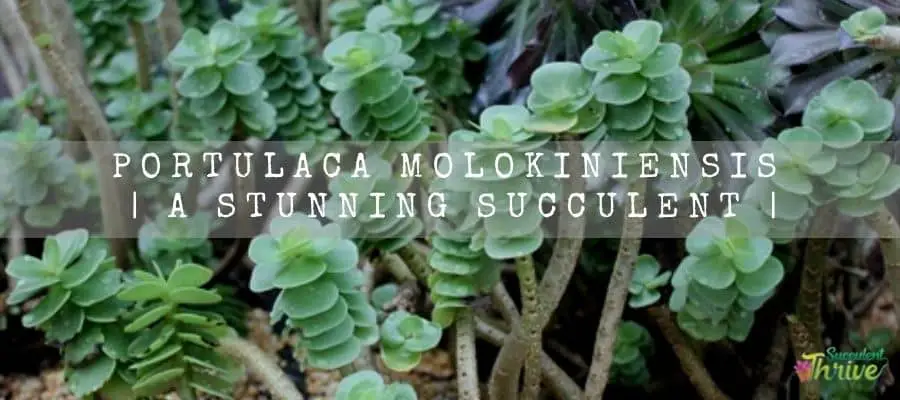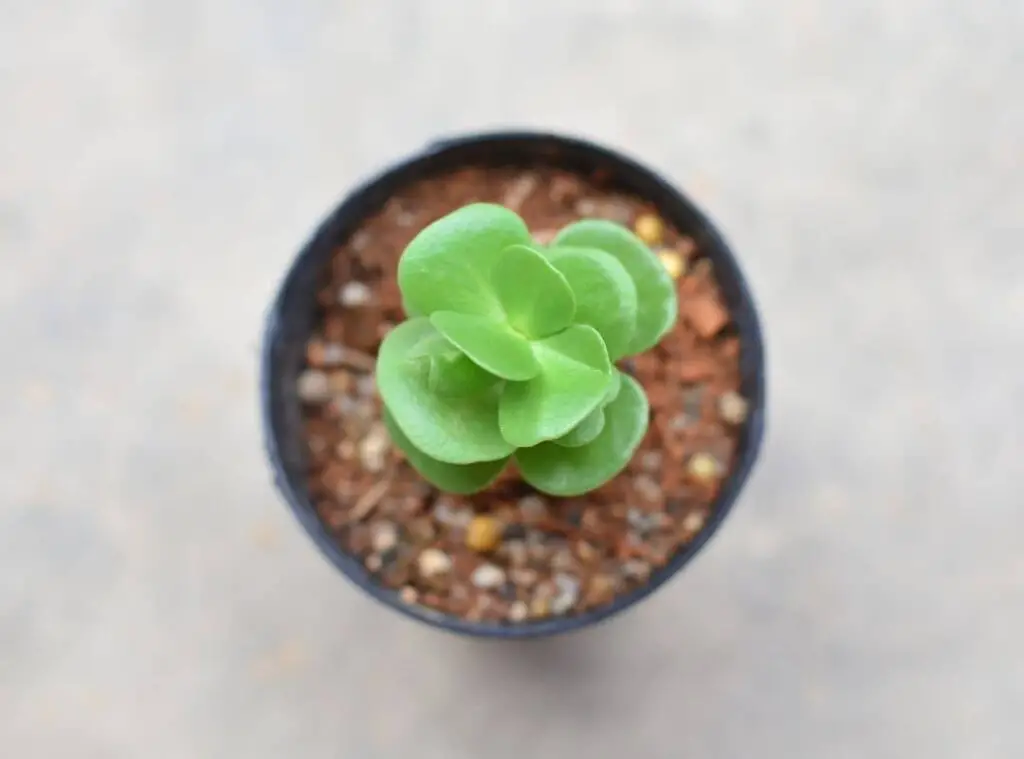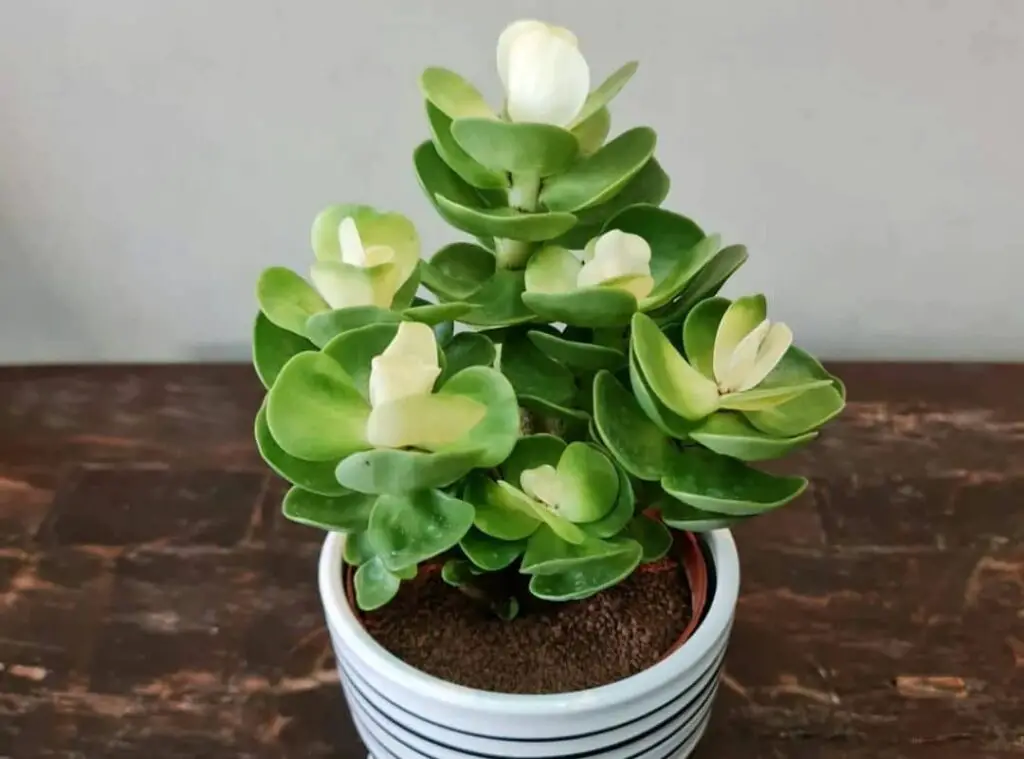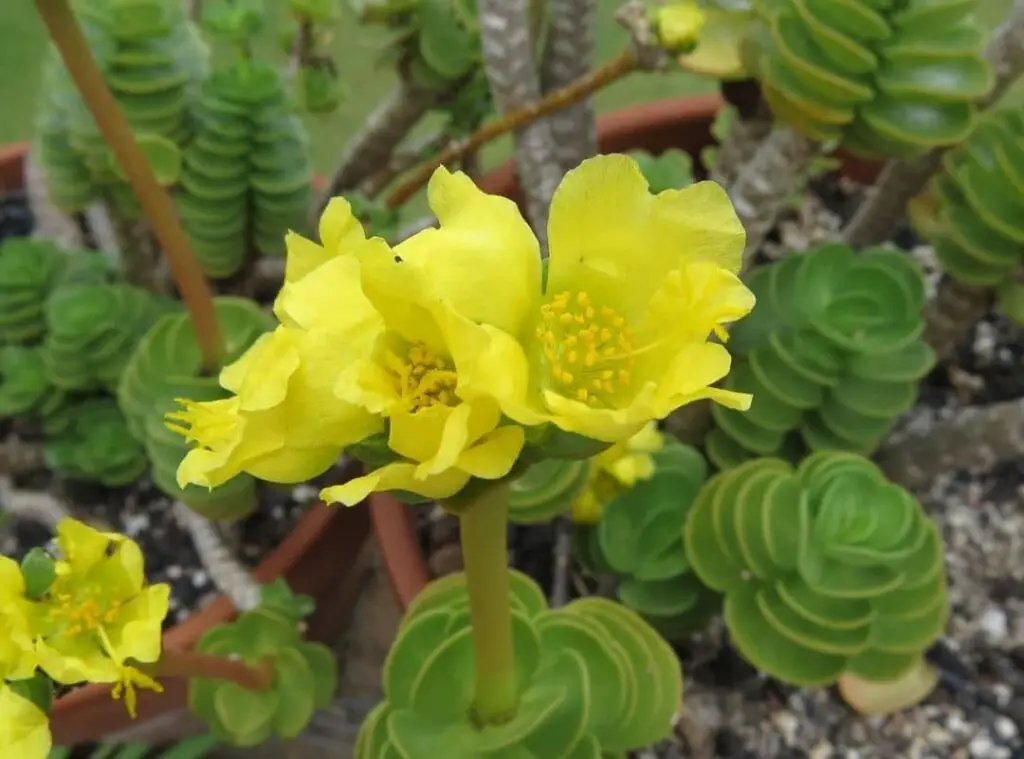Portulaca molokiniensis are a unique and beautiful plant in the succulent world and they are originating from Hawaii.
These plants would usually make coastal areas as their natural habitats. These are regarded as an endangered species in the USA as you could rarely spot them there.
“Ihi” is what you could call these plants in common. These are hardy plants, and they can thrive well with minimum supervision from you. They will perform to their best potential if you grow them in the right conditions.
These are frequently self-propagating species when they grow in the wild. Anybody can grow these precious plants be it a fresher in gardening or even an experienced gardener.
So, brace yourself and get ready to learn about these amazing sets of plants. I will be covering how to identify the plants, the care tips you need to practice, the issues and the common bugs you may come across.

How do I identify Portulaca molokiniensis?
Portulaca molokiniensis plants tend to take a unique appearance as aforesaid. They look different when you compare them with others.
They would carry multiple branches and stems which would form in a clump manner. Consequently, it would form a dense shrub.
Once the plant spread, the shrub formation would further develop. Besides, the branches would also grow upwards whilst staying together.
Portulaca molokiniensis stems would be about 1 inch in diameter and they would form right upward from the base. Ultimately, they would be about 30cm – 45cm inches in height at maturity. Besides they would be 50 cm in spread too.
Portulaca molokiniensis leaves would grow in straight rows. Further they will carry four rows of leaves in each stem.
Those leaves tend to take a somewhat elongated manner. Moreover, those leaf tips would be round in shape.
They would be about 2 inches in length. You could spot these leaves in a wide array of colors. Those colors would vary from pale green to much darker green.
The leaves tips in the branches would tend to take an often-darker color. Additionally, they would usually grow in thick clusters.
Portulaca molokiniensis would be great picks for container gardening. Then they would continue to grow small in pots.
However, they would tend to grow taller without spreading a lot outwards. Chances are that they would form their stem beyond the leaves for a few inches.
Their stem would grow upwards, and it would be somewhat long too. When it comes to flower blossoming of the plants, those flowers would be small and tend to take a cup shape. You could spot them carrying shades of yellow.
Growth rate
Portulaca molokiniensis are rapid growers. It would be so pleasing to watch them flourishing when they grow to their best.
If they get the right growing conditions in place, they will reward you with extremely beautiful plants in return.
One look care guide
| Botanical Name | Portulaca molokiniensis |
| Common Name | Ihi |
| Plant Type | Succulent |
| Mature Size | 30cm – 45 cm height 50 cm in width |
| Sun Exposure | Full sunlight |
| Soil Type | Well draining |
| Soil pH | 6.0 – 6.5 |
| Bloom Time | late spring to late summer. |
| Flower Color | Yellow / golden |
| Hardiness Zones | USDA hardiness zones 9a – 11b ( 20 degrees Fahrenheit to 50 degrees Fahrenheit ) ( -6.7 degrees Celsius – 10 degrees Celsius ) |
| Native Area | Hawaii |
| Toxicity | Toxic |
| Average price | 10 USD |

How do you take care of Portulaca molokiniensis?
Light Requirement
It is crucial that you expose them to a lot of direct sunlight to grow vigorously. So, if you wish to grow them as outdoor plants, go ahead with a spot which is bright and sunny.
In a few words, you need to choose a place where they can gain at least six hours of morning direct sunlight on a daily basis.
Further they can also tolerate sunlight even longer and still grow well. These are used to grow in hot , arid conditions and due to that they can withstand strong sunlight.
On the other hand, when you grow them in containers indoors, you should choose a bright sunny windowsill.
I suppose the windowsill would be the ideal spot to locate them when you grow them indoors as that is where they can gain the maximum sunlight.
However, if you still assume the plants have a scarcity for sufficient sunlight, you could consider placing grow lights closer to the plants.
You can easily acquire the grow lights from your gardening center or even from your nursery. One might find this option as costly. However, it is noteworthy that it would be a great investment.
It is vital that Portulaca molokiniensis get sufficient sunlight as only then they can conduct the photosynthesis.
One might think that grow lights are electric and it won’t give the same light as the natural light. However, these grow lights are specifically designed for indoor gardening.
They would mimic the natural sunlight and I will assist the photosynthesis process to take place. Consequently, the plants can generate the energy they want for the plants to flourish.
Temperature and humidity
Portulaca molokiniensis used to grow in hot and arid conditions. They are fans of sunlight as well as in heat.
So, when you cultivate them, you need to provide the same conditions they get in their natural habitats.
Portulaca molokiniensis plants will not withstand the colder conditions at any time. So, avoid exposing them for extremely colder weather conditions.
If you are someone who lives in a mild climate, you can grow them in your beds outdoors as they can tolerate those weather conditions.
Having said that if you live in much colder conditions, I suggest the safest and the best thing to do would be to grow them indoors.
Or else you can grow them in containers and locate them outdoors during spring and summer and then bring them indoors once the winter conditions approaches.
Keep in mind that these plants will not withstand the temperatures below 25 degrees Fahrenheit.
Beware of frost, as if you accidently expose the plants to frost, it will cause major problems in the plants. Literally the ice crystals can make the cell organization of the plants ruined.
In simple words, it would make the cells freeze and swell. Ultimately it would be fatal to the plants.
However, if you do not wish to shift them indoors, you could still be tactful in covering the plants with a light cloth or even with some fabric so that it would protect the plants from frost.
Is it cold hardy?
Portulaca molokiniensis have a frost tolerance of – 6.7 degrees Celsius ( 19.94 degrees Fahrenheit).
Growth Zone
Portulaca molokiniensis would opt to grow in USDA hardiness zones 9a – 11b ( 20 degrees Fahrenheit to 50 degrees Fahrenheit . ( -6.7 degrees Celsius – 10 degrees Celsius).

Watering Requirement
Portulaca molokiniensis grow in hot and arid conditions when they grow in the wild. That indication itself proves the point that they can thrive with minimum water levels.
So, keep in mind that Portulaca molokiniensis are not the set of plants which will tolerate excess water.
Portulaca molokiniensis leaves are wide and carry an absorbent surface.
Hence, they can retain moisture for extended periods. As such, you do not need to water them often. I recommend the ideal frequency would be to water them once every ten days.
Further when you water them, you do not need to soak the plants with water. Ideally a light sprinkle of water to moisten the plants would do.
It would be sufficient to keep the plants healthy. Watering the plants properly and growing them in a well-draining soil mix goes hand in hand.
As such, ensure that you provide a soil mix which has excellent drainage too. Additionally, the pot also should consist of sufficient draining holes so that excess water could move away freely.
Keep in mind that you should not make the plants roots sit in water as it would lead to the death of the plants.
Soil Requirement Type / pH.
When it comes to providing the right care treatments, providing a right soil mix is the most crucial thing. In fact, it has a greater impact in resulting a healthy growth of the plants.
So, a soil mix which has excellent draining would work well with these plants. So, when you select the right soil mix, the most important thing you need to check is whether they have excellent drainage.
Once you provide an excellent drainage in the potting medium, it would make sure that the plant’s roots would not sit in waterlogged conditions. Ultimately it would avoid any potential root rot which could take place too.
In addition to excellent drainage, it is important that the selected substrate has a good aeration too. That would further enhance the draining of the soil mix.
So, I recommend making a soil mix which consists of cactus potting soil and mineral grit at a ratio of 1:1.
To further elaborate on mineral grit, it is what you add to the potting medium to fasten the draining of the soil mix. You may use a mix of coarse sand, pumice perlite or even use them individually too.
To further explain on these elements, coarse sand, this is a sand type which has thicker heavy granules included, there will be more space among each individual granule.
Since there is adequate space among the granules, it would allow the excess water to move away freely without making the sand thicken. On the other hand, pumice Is more like a type of stone which has natural gas filled.
These stone gas bubbles would provide a good aeration in the substrate, and it would ensure that excess water is draining away freely.
Consequently, it would assure that there is good drainage in the soil mix. On the other hand, perlite is more like a substance which has volcanic minerals included.
Those volcanic minerals have a high-water content and the larger particle will ensure that there is a good draining available in the soil mix.
Pot size Potting and Repotting
I suggest choosing a pot which has ample drainage to grow the Portulaca molokiniensis plants.
In other words, your selected pot needs to carry at least one or two draining holes in the bottom so that it would drain away the excess water from the pots.
In addition to that, you need to select a pot which has a high porosity to grow the Portulaca molokiniensis.
Once you provide a high porous post , it would make sure that the excess water is evaporating at a rapid pace without retaining in the pot which is exactly what the Portulaca molokiniensis plants require.
When it comes to repotting, keep in mind that Portulaca molokiniensis would somewhat prefer to stay rootbound for some time.
However, if you freshly bought them from the garden stores and if you had kept growing them in soil for too long, I suggest the best would be to transplant them.
Once you repot them, it would provide new growing conditions for the plants. That would consequently allow the plants to absorb nutrients freshly.
If you keep growing the plants in the same pot, chances are that all nutrients would be depleted. So, I recommend repotting the plants every two years.
Where to Plant
As explained in the above, Portulaca molokiniensis have strong demand when it comes to sunlight.
Hence when you select a place to plant them you need to be mindful of this fact and choose a place where they can gain sufficient sunlight.
Further when you pot them, you need to select a pot which has ample draining as well.
Fertilizer and time of year
Portulaca molokiniensis are somewhat demanding when it comes to fertilizing. Having said that, too many fertilizers would also cause trouble for them.
Consequently, it would make the plant’s leaves black. Further chances are that it may even kill the plants too.
So, if you accidentally end up over feeding them, you could water in larger quantities and dilute the fertilizer so that it would avoid further repercussions.
Further you can apply the fertilizers when they are actively growing in spring and in summer. Refrain from feeding them when they are in the dormancy.

Flower
Portulaca molokiniensis blossoms with flowers in yellow and in gold colors. You could spot the flowers to emerge in late spring to late summer.
Read More about there flower here
Dormancy
Portulaca molokiniensis are winter dormant plants.
Toxicity
Portulaca is toxic to cats and dogs. The severity of the toxicity completely depends on the ingested dosage and the health of the animal.
If your pet is dehydrated the toxic can cause severe damages such as vomiting and fatigue. If the pet is hydrated and healthy the plants toxic may not cause harm.
However if your pet ingested Portulaca, you must visit your veterinarian for further instructions.
Special Care tips
Place your Portulaca plant unreachable to your pet. Keep the plant on higher shelves or make barriers around the plant.
Use protective gloves when working with this plant.
Also I recommend pruning the plants once in 2 or 3 months. So that it would avoid making the plants look neat and pleasant.
Common Bugs and issues
You could commonly come across moldy leaf disease mainly. Over watering is what could be the main culprit here.
They may suffer a disease called white rust. White rust is more like a powdery coating which could develop on leaves.
They may spread faster if you do not treat them on time. I recommend using a diluted apple cider mixture spray for these. You need to dilute it to 1:1. Keep applying this for a few days until you get rid of the coating entirely.
Many people tend to make the mistake of over watering when looking after these plants. if you expose the plants roots for excess water, it would only lead to the rot of the plants.
The constant exposure for waterlogged conditions would only be lethal on the plants as it would lead to root rot. So, ensure that you adhere to the right watering tips so that you will not have to go through these conditions.
Propagation
You can propagate the Portulaca molokiniensis using the seeds. What is special about these plants is that these seeds can self-propagate.
However, if you wish to propagate them using their seeds, you simply have to obtain their seeds and then wither for a few days.
Next you can sprinkle them on a soil layer which is pre moistened. You could spot them producing new shoots from the seeds.
Further you may also come across new plants that are merging from those too. keep watering them lightly until you spot them producing healthy plants.
Many people opt to go ahead with the cuttings as it is relatively an easy process to do. However, to do that you need to use all sterile knives and then make the cutting.
If you end up using dirty tools, chances are that it could lead to infections in the plants and ultimately it would ruin the entire propagation process.
Further if you don’t use sharp tools, you won’t be able to create a sharp cutting and chances are that it may damage the cutting.
So, once you obtain the cuttings you need to keep them in a spot at room temperature which will allow them to develop callousness.
After that you could insert the cuttings in a fresh pot in which you have filled with a well-draining soil mix.
Water them lightly for a few days until you spot them forming roots. Within a few weeks’ time you could spot them forming a new Portulaca molokiniensis plant with all its glory
Portulaca molokiniensis benefits
Portulaca molokiniensis are great picks for container gardening be it indoors or outdoors.
Conclusion
To wind up, Portulaca molokiniensis is a plant species which anybody would not hesitate to have. It is such a glamorous plant which all will fall in love with. So, I hope you found the above-mentioned information useful and that you were able to improve your knowledge on how to grow them well.
Read Next : Crested Echeveria Frosty | An Unusual Succulent |
